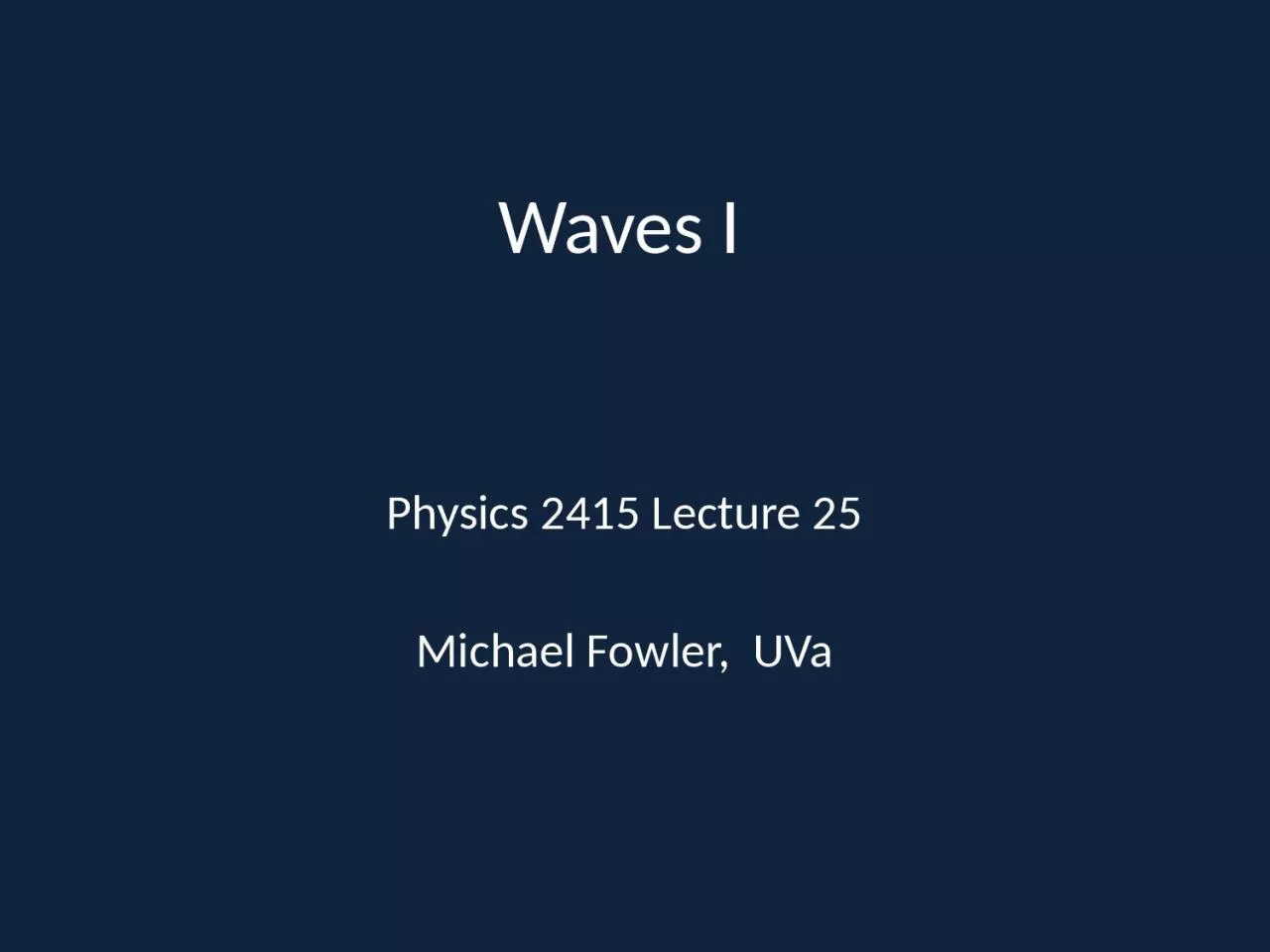

Michael Fowler UVa Todays Topics Dimensions Wave types transverse and longitudinal Wave velocity using dimensions Harmonic waves Dimensions There are three fundamental units in mechanics those of mass length and time ID: 1022639
Download Presentation The PPT/PDF document "Waves I Physics 2415 Lecture 25" is the property of its rightful owner. Permission is granted to download and print the materials on this web site for personal, non-commercial use only, and to display it on your personal computer provided you do not modify the materials and that you retain all copyright notices contained in the materials. By downloading content from our website, you accept the terms of this agreement.
1. Waves IPhysics 2415 Lecture 25Michael Fowler, UVa
2. Today’s TopicsDimensionsWave types: transverse and longitudinalWave velocity using dimensionsHarmonic waves
3. DimensionsThere are three fundamental units in mechanics: those of mass, length and time. We denote the dimensions of these units by M, L and T.Acceleration has dimensions LT-2 (as in m/sec2, or mph per second—same for any unit system). Write this [a] = LT-2.From F = ma, [F] = [ma] so [F] = MLT-2.
4. Using DimensionsExample: period of a simple pendulum. What can it depend on?[g] = LT-2, [m] = m, [ℓ] = L.What combination of these variables has dimension just T? No place to include m, and we need to combine the others to eliminate L:[g/ℓ] = T-2, so is the only possible choice. Dimensional analysis can’t (of course) give dimensionless factors like 2.
5. Dimensional Analysis: Mass on Spring From F = -kx, [k] = [F]/[x] = MLT-2/L = MT-2.How does the period of oscillation depend on the spring constant k?The period has dimension T, the only variables we have are k and m, the only combination that gives dimension T is , so we conclude that T . .Extension xSpring’s forcem
6. Waves on a StringA simulation from the University of Colorado
7. Transverse and Longitudinal WavesThe waves we’ve looked at on a taut string are transverse waves: notice the particles of string move up and down, perpendicular to the direction of progress of the wave.In a longitudinal wave, the particle motion is back and forth along the direction of the wave: an example is a sound wave in air.
8. Harmonic WavesA simple harmonic wave has sinusoidal form:For a string along the x-axis, this is local displacement in y-direction at some instant.For a sound wave traveling in the x-direction, this is local x-displacement at some instant.Amplitude AWavelength
9. Wave Velocity for StringThe wave velocity depends on string tension T, a force, having dimensions MLT-2, and its mass per unit length , dimensions ML-1.What combination of MLT-2 and ML-1 has dimensions of velocity, LT-1?We get rid of M by dividing one by the other, and find [T/] = L2T-2 :In fact, is exactly correct!This is partly luck—there could be a dimensionless factor, like the 2 for a pendulum.
10. Sound Wave Velocity in AirSound waves in air are pressure waves. The obvious variables for dimensional analysis are the pressure [P] = [force/area] = MLT-2/L2 = ML-1T-2 and density [] = [mass/vol] = ML-3.Clearly has the right dimensions, but detailed analysis proves where = 1.4.This can also be written in terms of the bulk modulus , but that differentiation must be adiabatic—local heat generated by sound wave pressure has no time to spread, this isn’t isothermal.
11. Traveling WaveExperimentally, a pulse traveling down a string under tension maintains its shape: Mathematically, this means the perpendicular displacement y stays the same function of x, but with an origin moving at velocity v:vtSo the white curve is the physical position of the string at time zero, the red curve is its position at later time t. yx
12. Traveling Harmonic WaveA sine wave of wavelength , amplitude A, traveling at velocity v has displacement 0vtxy
13. Harmonic Wave NotationA sine wave of wavelength , amplitude A, traveling at velocity v has displacementThis is usually written , where the “wave number” and .As the wave is passing, a single particle of string has simple harmonic motion with frequency ω radians/sec, or f = ω/2 Hz. Note that v = f